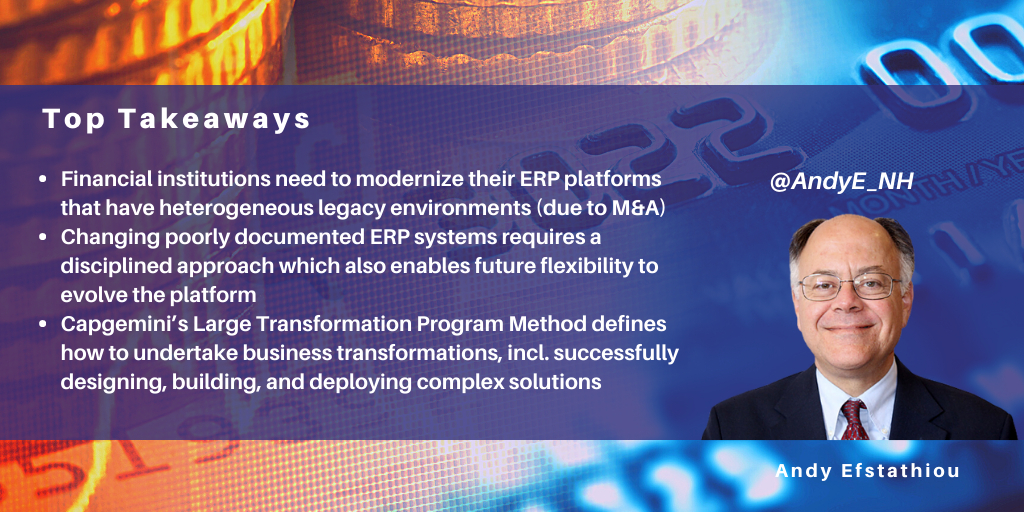Search posts by keywords:
Filter posts by author:
Related NEAT Reports
Other blog posts
posted on Aug 25, 2023 by Andy Efstathiou

Financial institutions use legacy ERP solutions to monitor, control, and report on their business activities. At large institutions, most of these solutions were deployed in the 1990s and have inflexible architectures that need the requisite functionality to report on modern products, regulations, and industry practices. In this blog, I look at how Capgemini is helping clients tackle this challenge.
The Challenge
All financial institutions need to modernize their platforms because they have heterogeneous legacy environments due to M&A and an operational environment organized by product lines. In addition, differences in regulations and technology availability have required platform customization for each market. The market share for ERP solutions varies by sub-industry and specific market. The heterogeneous nature of all these systems makes consolidating product lines and general ledgers very difficult and often requires manual intervention.
In addition, these legacy systems face challenges, including:
- New regulations, such as IFRS 15 for banks and IFRS 17 for insurance companies, that will necessitate modernizing ERP platforms to remain compliant
- Legacy ERP systems do not have the functionality to track and report ESG issues. CFOs and all senior executives are beginning to implement ESG programs in their institutions and need to modernize their ERP systems to support ESG initiatives. Future system requirements for ESG services are not defined, so today’s platform renewal must enable flexibility to introduce new functionality with minimal disruption to the existing platform
- CFOs must close books quickly with data that provides one version of the truth. When the company decides to reorganize itself, the executives must be able to restructure systems across the new organizational structure and still generate the same reporting numbers. Today, with legacy EPR systems deployed in the 1990s, that is not the case.
As these market conditions continue to evolve, ERP solutions should be able to adapt quickly with minimal disruption to remain relevant.
Capgemini’s Approach to ERP Renewal
Capgemini has developed a program for ERP renewal in financial services to address this challenge in partnership with significant solution vendors. The program is customized by sub-industry (i.e., banking, capital markets, P&C insurance, and life insurance). Today, Capgemini partners with three solution vendors to address these problems: SAP, Oracle, and Workday.
Executives who buy these services are typically the CFO, CHRO, or CPO (Chief Procurement Officer).
Capgemini’s offering to modernize ERP platforms has five components:
- Assessments and roadmaps
- Implementation services
- Integration services
- Migration to the cloud
- Application management services.
During modernization, Capgemini rearchitects the technology environment to improve efficiency, declutter the environment, and remove customization. This “lift, shape, and shift” process to a cloud environment enables the client to convert from a Capex to an Opex cost model while achieving greater operational agility and a simplified technology environment.
Capgemini uses tools and accelerators to deliver this type of large complex project. The tools are part of its proprietary Large Transformation Program (LTP) Method. The method defines how to undertake business transformations, including successfully designing, building, and deploying solutions that can continue to evolve over time. An LTP is defined as a multi-year, multi-release, and multi-project delivery of solutions that evolve over multiple versions. Typically, LTP projects are globally delivered, requiring multi-tower services from a group of service partners. Typical benefits include productivity improvements of ~20% and cost reductions of ~30%.
Client Example
To illustrate how this is done, let’s look at an engagement with a leading multi-national, universal bank headquartered in London that wanted to transform its finance activities around an integrated general ledger (S4HANA) across multiple countries.
Business situation
The client wanted to modernize systems for country ledgers, A/P, A/R, project accounting, and fixed assets. The goals for the project were:
- Standardization and centralization of business processes
- Integration to feeder systems (e.g., T&E, B2B commerce, etc.)
- Integration of data platforms to risk data platform
- Enhance planning, budgeting, and financial closing systems using SAP FSDP to enable faster closing
- Improve cost allocation, profitability reporting, and transfer pricing capabilities.
Project scope
Capgemini delivered the following:
- An offshore COE for SAP S4HANA to support project delivery and ongoing maintenance and support
- Implementation of a Finance and Risk Data Platform
- Finance and profitability reporting using the client’s product data fields to allow franchisees and sales teams to receive accurate commissions on financial product sales
- Common data definitions and quality metrics to facilitate accurate data feeds across all bank systems.
Impact
The project delivered the following results:
- Center of excellence built with 98% offshore resources, which significantly reduced costs
- Reduced synchronization data from third-party systems to S/4 by 90% with 100% error-free status
- Implementation of Solution Manager automated job monitoring resulting in a 70% reduction in manual effort
- Migration from an HEC environment to a Hyperscaler environment reduced costs by 50%
- Reduction in manual effort and cost from move to cloud delivery
- New architecture makes implementing future platform changes easier and supports future business growth.
Summary
Large financial institutions have complex, heterogeneous legacy ERP systems that must change to address current market demands. Further, these systems will need to continuously evolve to remain relevant. Changing these poorly documented systems is a nightmare without a disciplined approach. Capgemini has developed an offering that cost-effectively addresses this challenge and enables financial institutions to improve user experience across employees, partners, and regulators.
